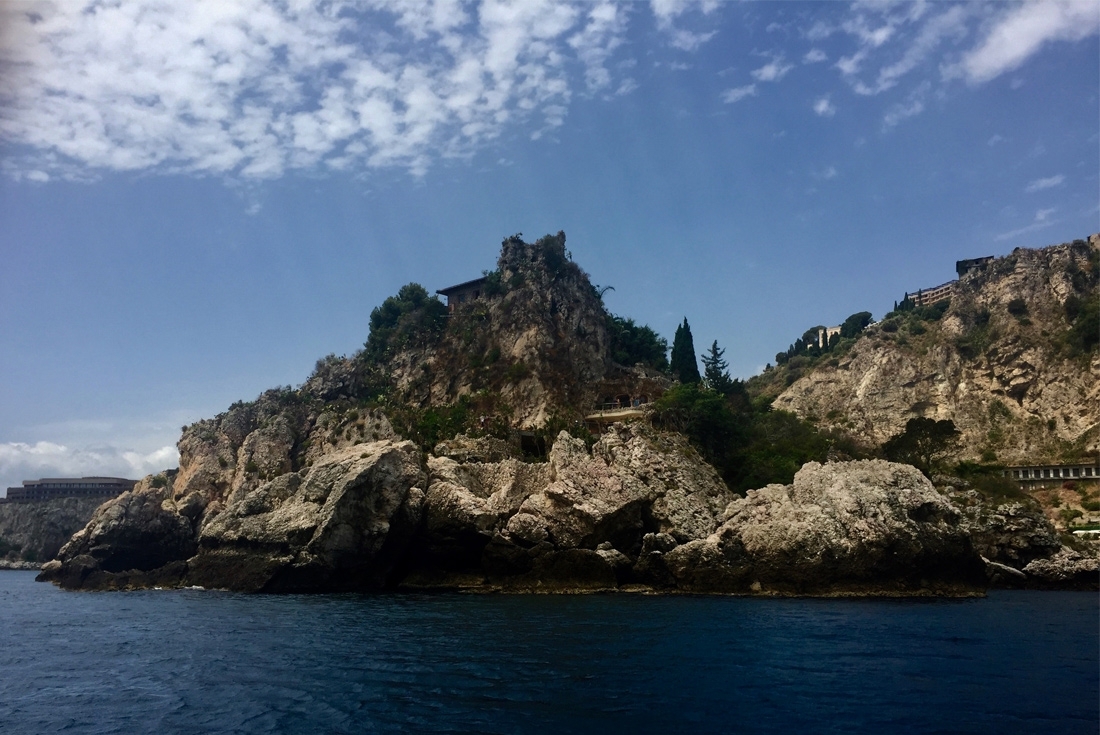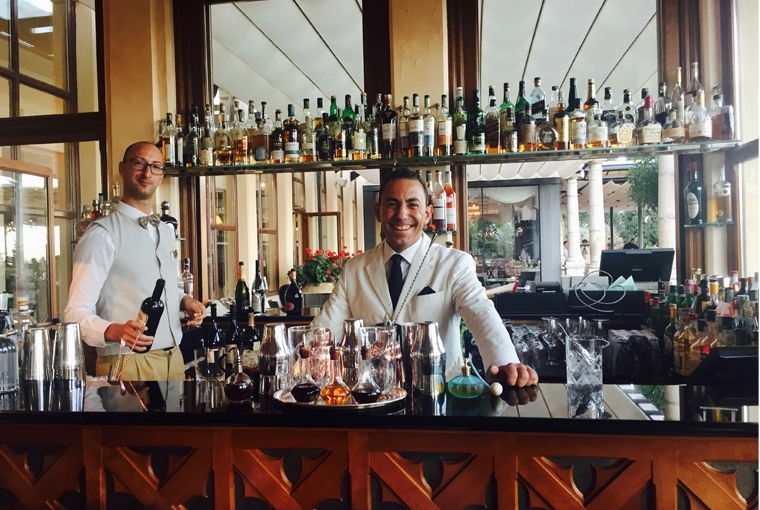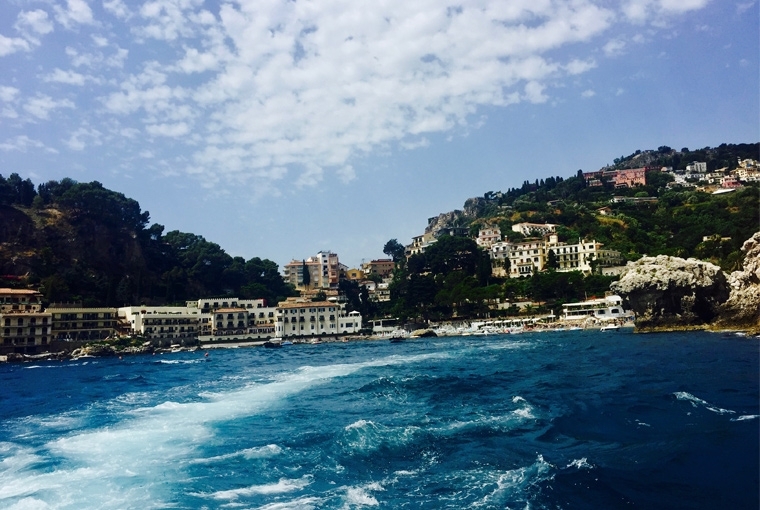
Photography by Rymn Massand

Photography by Rymn Massand
I have lived in Paris, Delhi, New York City, London…have dreamed of living in Rome, retiring in Provence, with a chalet in the Italian alps thrown in for good measure…in short I felt that after all my wonderful travels I knew a bit about beautiful places in the western hemisphere where I feel at home…but nothing prepared me for my encounter with [and subsequent love for] Sicily.
I flew into Sicily from Mykonos where I had spent a wonderful week doing little else than gazing out over the bright blue of the Ionian Sea, sketching and admiring the cacti. What I knew of Sicily was that it is the largest island in Italy located just around 100 miles northeast of Tunisia. Invaded by the Greeks, Romans, Byzantines, Arabs, Normans and the Bourbons the influences of all these settlers are still visible, predominant amongst them being the Greek. At a glance the Sicilians are darker skinned than the mainland Italians, reflecting the Greek and Arab past.
There are of course the usual references to the Mafia [the modern day version is apparently almost respectable (!) and much more sanitized], and the Godfather movies…visions of a young and extremely handsome Al Pacino clad in a soft white cotton shirt and the traditional Sicilian Coppola [which is the flat cap typically worn in Sicily, Calabria and Sardinia] through the rugged countryside loomed large.
Landing in Catania [which is one of the biggest towns in Sicily], I zoomed down in the direction of Taormina, home to the beautiful duo of Belmond Hotels [which I had heard much about and was eagerly anticipating]. Windows down in the early July heat, Paolo Conti on the stereo, and the wonderful smell of miles of Oleander planted along the entire route seemed like the right way to begin my 4 days in Taormina.
The coastal views as I got closer to my destination were stunning, endless blue with small outcroppings of islands, some seemingly merely a collection of rocks…but knowing a bit about the mythology of the island—Sicily being the Island of the Cyclops in Homer’s Odyssey—cast them in a different light. The rocks were apparently the stones thrown at Odysseus! To the left this incredible sea/ocean with ancient tales come to life and to the right the lushest foliage imaginable. What a contrast to the dry scrub of Greece! Palms, oleander, lemon trees, orange groves, Olive trees, cypress, Cactus, and perhaps my favourite trees in the world the Italian Stone Pines with its flat top and twisted trunks…a thing of beauty.
What I discovered was that due to the minerals in the soil [nurtured by centuries of volcanic eruptions from Mt. Etna], eastern Sicily is one place where every kind of vegetation grows all year round…Lemon tress bloom even in winter, everywhere you look there are vineyards, olive groves, apricot trees, apples, pears, blueberries, the sweetest tomatoes in the world, Pistachio, Almond and Hazelnut groves, mushroom farms [where the famous and eye wateringly expensive Ovolo mushrooms grow], Chestnut woods, Forests of truffles and so much more. For a region where food is the center of family life, perhaps it is fitting that they are surrounded by such bounty. There is a Sicilian saying,“ Even if you are poor in Sicily, you will never starve”. I understood what that meant once I saw the garden of Eden that is Sicily.
Pulling into the driveway of Belmond Villa Sant’Andrea, built in 1830 as a private residence and converted into a hotel in the ‘50’s, feels akin to a theatrical entrance onto a film set…all the Belmond properties pride themselves on their unique locations, and the Sant’Andrea surely sits on one of the more spectacular ones. Set on a private beach with a view on to the beautiful bay of Mazzaro, it is unusual in the fact that it is surrounded by lush tropical gardens, bringing together the best of all worlds…the blue Mediterranean, verdant green gardens, and the majestic cream colored villa with its terracotta coloured rooftops.
It is with great pleasure that I greet the very good looking, welcoming staff, and enter this hotel that feels like the home of an extremely wealthy and eccentric uncle with impeccable taste. We walk through corridors lined with prints of textiles, beautiful maps of the region and various artworks to my room with a view.
The bay stretches out before me, the hills of Taormina as a backdrop, and a silver platter of Sicilian cherries and almond cakes [almost every Sicilian dessert is made from local nuts] welcome me, setting the tone for the next few days of pleasure.
There are hotels that impose their own aesthetic onto a their surroundings, and there are hotels that seem to belong to exactly where they are situated, blending in the old, the new, and nature seamlessly. The Villa Sant’Andrea [along with its sister hotel the Grand Timeo] belongs to the latter group, and the intention is evident in every detail.

Photography by Rymn Massand
There were so many touches that made the hotel unique, but none more so than the ceramics on display in both their properties. I noticed the ceramic pinecones first scattered in various places in varying sizes and colours and then the strange plant like shapes (some resembled lotus roots, others cacti and pineapples). All beautiful and all in the most sublime shades of blue, greens, browns and all variations thereof…. I was so taken with these; I had to ask the hotel to introduce me to someone who could give me an education in the history of these ceramics. At the Belmonds, one just needs to ask, and that very evening we walked into the town of Taormina and into a shop called Ceramiche Dell’artigianto Siciliano Manago that opened up a whole new world for me.
It is an explosion of colour, shapes, sizes: pinecones, and vases shaped as Moor’s heads, bowls and owls, angel figurines [traditionally known as La Matrangela-mother of Angels], cups and water pourers, and so much more…an insane treasure trove run by a father and daughter duo, they are experts in everything ceramic related in Sicily and beyond. Tina [the daughter] sat me down for a quick lesson in local ceramics.
A nearby town called Caltagirone (which is 1000 years old and originally an Arab settlement) is home to 22 different ceramic artists who also happen to be 6th/7th generation potters. This is the main source of ceramics in Sicily and Italy. There are many different styles, but one of the threads that connect them all is that they are all somehow linked to either mythological stories [See the story in appendix about Moor’s head vases], or local flora and fauna [the pinecone being a perfect example: Long thought to be a Symbol of fortune, prosperity and abundance it decorated the entrances of aristocratic houses as a token of hospitality] and even the eruptions of Mount Etna over the years have inspired the designs. Evidence of this love for ceramics is visible all over the streets of Taormina. We took a quick tour of the streets in the heart of town and saw balconies covered with ceramic heads, windows dedicated to statues of saints and angels, front entrances decorated with ceramic lemon trees and more pine cones, truly a living breathing art form that is nurtured, treasured and used daily.
After hours spent surrounded by ceramics and the throngs in the town of Taormina, I needed a moment of calm [and a drink], and while walking towards the main Piazza, came upon a bar and open-air restaurant called Wunderbar. Set under blooming trees next to one of the old gates of Taormina it is a lovely spot to sit and watch the local life drift by. Taormina is crowded in summer, with the ancient Greek roman ruins of the famous theatre and the views, the food and the general beauty of it all…I spoke to a few people who recommended the autumn and even the winter months as a wonderful time to visit, the climate is temperate and trees are still in bloom, and the sea is still warm enough for a swim.

Photography by Rymn Massand
The next morning after a delicious breakfast on the sunny terrace, the beach awaited… I needed to work off all the seafood pasta [sublime fresh red prawns with a calabrian chili] hazelnut cake and the copious amounts of Nero D’Avola from the Feudo di Mezzo vineyards [which is the Planeta Winery’s 5th location in Sicliy-located on Mt. Etna it boasts a stunning location inside a lava flow dating from 1566, in the heart of one of the most famous areas of the volcano itself!]. One of the wonderful advantages of the Villa Sant’Andrea is being able to walk right off the terrace onto the beach and the water…with rocks and platforms to swim to, and no waves except the gentle lapping caused by a passing boat in the distance—it is the ideal spot for some morning exertion.
It is also a hard place to leave, but leave I had to…on to my next stop which is its sister hotel—The Grand Hotel Timeo. Built in the 1870s as a small private home by an Italian local known as La Floresta [translated roughly as the crazy man], it is located next to the famous Greek theater. Legend has it that he befriended a German painter by the name of Otto Geleg who was so taken with the Sicilian landscape [and who can blame him] that he painted it repeatedly and exhibited those marvels in Europe. Apparently no one in Northern Europe believed that such beauty was possible and all came to visit, making it a popular winter destination… business boomed, the home expanded incrementally and finally for the coup de grace an extremely wealthy Englishwoman Lady Florence Trevelyan came to make Taormina her second home and built the gardens upon which the present day Timeo sits. The gardens are vast, and have since been divided into the private part belonging to the hotel and the public part just across the street. Overlooking the sea from upon high [the Grand Hotel Timeo is set in the hills of Taormina] the public gardens are lush, varied with winding paths, fountains, tennis courts, and old stone benches with endless views for a quiet moment of reflection. A mere two minute walk across the way from the hotel, it is spectacular and a must see.
This influx of writers continued into the early 1900s with D.H. Lawrence and Oscar Wilde being amongst the literary luminaries visiting and staying through the winters – so much so that the grand terrace of the hotel is known as the ‘literary terrace’.
Aside from its history, it is also a beautiful terrace to sit at for an early evening cocktail. With Mount Etna in the distance, the sea sparkling just below, and the gardens that surround…it doesn’t take much more to feel that things couldn’t possibly get better. However, they do…with the arrival of bartender extraordinaire-Alfio Liotta. [He was just named as one of the best bartenders in the world by Conde Nast Traveller magazine]. He is the perfect embodiment of all that an Italian bar tender should be. Charming, handsome, witty…with the martini making skills of few others, I would come back just for the experience of having him make me a cocktail, especially his version of an Aperol spritz which he calls an Etna Spritz.
Like its sister hotel, The Grand Timeo also sits in a spectacular location, perched as it is above the sea in the verdant hills, with one of its gates opening into a private passage into the Greek theatre, and the streets of Taormina just beyond its entrance. The theatre, which was built in the 3rd century BC, is worth the trip alone, and while the town of Taormina may seem crowded it has some lovely things to see. Being an ancient town it was protected by a series of walls with a triple fortification system. There are 2 main gates on either end of town- the Porta Catania [originally made in the 15th century]. And the Porta Massina. Both are worth a stroll from end to end. As one would expect there are plenty of shops selling the usual trinkets, but the ones I liked were Il Sandale Caprese [which sells handmade sandals that they can customize within a couple of hours], and Prestipino which is a boutique that had the most exquisite jewelry.
There is no better base to explore the town from than this beautiful hotel. My room had a stunning view over the bountiful gardens, the bay and the ever-present Mount Etna softly belching out wisps of smoke in the distance. The plan for my last day was to visit Mount Etna [which is the tallest active volcano in Europe] and have a tour and tasting at the Planeta Winery. After a delicious [and elegant] breakfast on my balcony I set course, accompanied by my knowledgeable and charming guide Tommasso Politini who gave me the history of Etna as we drove an hour plus towards it. There are 2 ski resorts on Etna, and one of the few places in the world where one can ski during the day in the winter months and be at the beach in the afternoon for a cool dip in the sea. The drive to Etna itself is lovely, winding through forests of chestnut trees, the yellow flowering Ginestra bush, and blackberries growing wild along the road. We stop a few times to look at a local church, or admire a piazza and finally get to the high enough to see the fields of lava that stretch as far as the eye can see…interspersed with young trees and flowers that have grown within the rivers of lava since the last major eruption in 2002. The vast tracts of lava with new roads built through them are a sight to behold…. akin to a lunar landscape, surreal and beautiful. A long hike up the hills of Etna and a view of the actual volcanic fissures would be something I would plan on for my next trip [we didn’t have the time this time]. As it was we drove quite a way up and stopped at a collection of huts, one of which was a photo gallery [Ethnic Photo Gallery] belonging to Dario Lo Scavo who is a volcanic photographer and intrepid climber and has photographed and filmed multiple eruptions over the last years. The photos and videos are on display and impressive to watch! I needed a memento of Etna beyond a postcard and luckily for me his gallery also sold bracelets and small items made from lava [which is apparently the strongest rock after Titanium]. Bracelets in hand, we drove down to the Fuedo de Mezzo Winery belonging to Planeta Wines. Past cherry groves and fields of Olive trees, the black soil of the lava adding its own richness to all the vineyards and vegetation around. Set amongst 24 hectares of vineyards Planeta is one of the oldest family vineyards in Sicliy. 17 generations have been making wine and olive oil and they have now expanded to 6 wineries in every terrior in Sicily. This particular location boasts the minerals in the soil of Etna that make the wines unique…
It was a lovely afternoon spent exploring the vineyards, with an olive oil tasting and a wine tasting with a delicious lunch prepared by the local ladies who worked at the vineyard. My favourites were the Etna bianco and the Plumbago red…I ordered 2 cases of red and 1 of white plus 6 bottles of their sublime olive oil and as they ship internationally it means I can keep my memory of Sicily alive in the cold NYC winters.
Slightly tipsy, and very happy I made my way back for a final afternoon at the pool at the Grand Timeo, a last stroll through the gardens and a sentimental goodbye.
It’s hard when you fall in love with a place and have to leave – I wish I could be a modern day version of Lady Trevelyan, surrounded by the beauty that is Sicily all year round!
Arrividerci Sicilia, see you soon.
A couple of must dos:
[1] A private boat ride which takes around 2 hours and leaves from their beach…discovering the rugged coastline, stopping at the famous Blue Grotto, and circling the Isola Bella [which is better seen from the water, choc a bloc as it is with day trippers, families and general sun bathers], and then heading for the open seas with Taromina behind you, and the Med ahead…we stopped in the middle of the sea for a swim and a snorkel before heading back.
[2] An afternoon in a cabana on the beach with a glass of crisp white wine [from the Planeta Vineyards which nestle in the foothills of Mount Etna], and a plate of prosciutto from the Suino Nero de Nebrodi [the famous Black pigs of Nebrodi Mountains], where the pigs are allowed to roam free through the oak forests, producing a most delicious flavor -was the beginning of my delightful culinary exploration of the region.
Text Rymn Massand